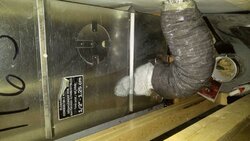This is taken from the article:
Building scientists say that the air in a house must be exchanged at least every three hours, or one-third of an airchange per hour, to control moisture from cooking and washing and to manage odors. One third of an air change in a 1500 square foot house is 4000 cubic feet, or 66 cfm. Note that this is the absolute minimum air change for healthy living and that most houses older than 20 years have natural leakage rates far higher than this in winter. So the air consumption of a wood stove is a tiny part of a much larger exchange of air between the house and outdoors.
The main disadvantage of taking air from inside the house is that the pressure environment can be adversely affected by powered exhausts. However, depressurization caused by powered exhaust flows is predictable and manageable, unlike the more random and unpredictable effects of wind on outdoor air supplies. The worst-case indoor air pressure environment can be measured using the house pressure test procedure, and can be controlled either by limiting exhaust flows or by installing a powered make-up air system.
In general, therefore, wood stoves and fireplaces that are vented by natural chimney draft should draw the air for combustion from the room in which they are located. Where necessary the indoor air pressure should be controlled to minimize depressurization.
The guy actually is making the point that you need outside air. He says 25 CFM is only a tiny increase from the existing 66CFM. That is more than a 30% increase! One third of the air infiltration is related to the stove. That is not a tiny amount, it is a massive percentage of air exchange. He then goes on the finalize the article by saying you may need to add make up air in his last sentence. I believe he is referring to a heat exchanger to bring in warmed outside air while venting the house. They are great and if you are not supplying outside air to your stove the need for one goes up exponentially, but if you have outside air the need for one goes down.
What your missing and assuming is that he says a MIN. for health is 66cfm. THAT'S A MIN. for health reasons.
Hes not saying an average house has 66 cfm leakage. Only a SUPER TIGHT very small house will ever see a leakage rate that small.
Did you miss his next sentence?
"most houses older than 20 years have natural leakage rates
far higher than this in winter"
I had my late '70's tri level tested in 2010. It had a leakage rate of 1775cfm! 1775 cfm equates to 4.58ACH50 in my house!
Note from my test.
"Given the conditioned floor area, house volume and external surface area of the home, this is considered average in regards to air infiltration."
So my house with 1775 cfm leakage is average for its size and age.
here is some other notes from my test.
"newly built energy star certified homes in WI average around 1.50 to 2.50 ACH50."
If my home was at the average of a newly built energy star certified home built 7 years ago assuming 2 ACH50 it would equate to 775 cfm!
If I had 66cfm leakage that would equate to .17 ACH50.
The tightest most efficient house standards, Passive House, requires .6ACH50. More than 3 times the 66 cfm.
Forget 66 cfm, its not the real world for air leakage, 660 cfm is a closer average of the houses out there.
Another gem.
"old farm houses can be as leaky as 10ACH50 or more."
I had no significant air leakage at my wood stove.
In my average leaky 40 year old house the 25 cfm for the wood stove is 3% of the air leakage. Insignificant.
I had the test done to improve the energy efficiency of my home. I followed alot of the recommendations.
If your serious about the energy efficiency of your home start with a good energy assessment and follow the recommendations.
You'll know what your leakage is and how insignificant 25 cfm for a wood stove is.



